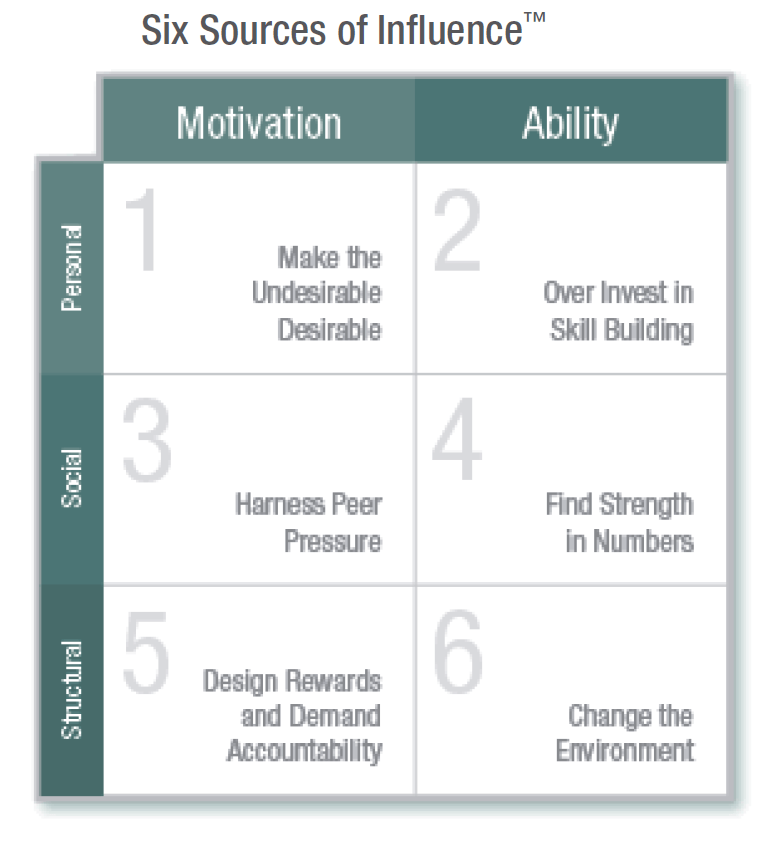Do You Feel Influential?
December 11, 2019 in Leadership & Influence
By Bob Turner
Do you feel influential? Perhaps you don’t believe you’ve ever truly attained that role of trusted advisor, or you simply feel you lack influence because you’re not in a position of leadership or authority.
Well, if you’re feeling inadequate or uncomfortable about your ability to influence others – I have good news! Here’s an easy-to-follow framework that I’ve used with employees, federal clients, executive coaching engagements, even friends and family.
| The Six Sources of Influence™ was developed by a group of behavioral scientists who formed a company called VitalSmarts. You can read more about this framework in the following VitalSmarts books: · Influencer – The New Science of Leading Change · Crucial Accountability – Tools for Resolving Violated Expectations, Broken Commitments, and Bad Behavior · Change Anything – The New Science of Personal Success |  |
The Six Sources framework shows that in order to be successful at a task or to change a behavior, you must have a high level of both motivation and ability (the columns in the framework). We then look at these domains across three different categories:
- Personal – The first two domains, Personal Motivation and Ability, relate to sources of influence within an individual (motives and abilities). We want to increase these. For Personal Motivation, we might bring to light how their work or behaviors impact the “greater good”. For Personal Ability we might address performance or knowledge gaps with training.
- Social – The next two, Social Motivation and Ability, relate to how other people affect an individual’s choices and abilities. The power of peer pressure can be a wonderful thing (or a bad thing). We want to be sure that we surround the person we’re trying to influence with champions of change that will support our cause.
- Structural – The final two, Structural Motivation and Ability, encompass the role of nonhuman factors, such as compensation systems, space, and technology. Structural Motivation focuses on the proper rewards and penalties. Structural Ability focuses on creating favorable processes, and work environment. It also focuses on providing the proper tools and technology.
In their white paper (How to 10X Your Influence), the VitalSmarts team states that: “Those who understand how to combine four to six sources of influence are up to ten times more successful at producing substantial and sustainable change.”
The Six Sources in Action! – An Example
Our topic this month is to Be the Change You Want to See in The World. And the Six Sources can also be used to influence ourselves for personal change, not just others. New Year’s Eve is just around the corner, so let’s see how influencing a very popular New Year’s resolution looks like using all of the Six Sources.
Goal: In 2020, I want to get healthy and lose weight!
Possible strategies for each domain:
Personal Motivation: Write a personal mission statement for 2020 and read it every day / tell your friends about your plans and ask for daily support and accountability.
Personal Ability: Research topics on nutrition or talk to a nutritionist / design a weekly healthy meal calendar / hire a personal trainer / research different cardio training programs.
Social Motivation: Make a list of friends (they support the new healthy you) and accomplices (they invite you to happy hour instead of the gym). Spend more time with your friends. You want peer pressure working for you, not against you.
Social Ability: Join a running or walking club / get several workout partners for the gym
Structural Motivation: Reward small wins – when you lose five pounds, then agree to go to a happy hour and celebrate or buy some new smaller clothes. Avoid penalties – if you don’t hit your weekly weigh-in, commit to walking an extra mile every day the following week.
Structural Ability: start packing a healthy lunch and snacks each day (vs. eating out) / pack your gym bag and commit to driving straight to the gym after work (don’t go home and be tempted to veg out) / start using a calorie counting app or FitBit / use visual cues – like putting sticky notes on your pantry and refrigerator reminding you not to snack late at night.
If you weren’t following this framework, then you may have only tried one or two of these strategies. But remember, the research shows that to have a higher possibility of success, we need to check as many boxes (domains) as possible.
Good Luck with becoming an Influencer in 2020!
References:
Grenny, J., Maxfield, D., & Shimberg, A. (2013 by VitalSmarts, LLC) How to 10X Your Influence. Retrieved from: https://faculty.medicine.umich.edu/sites/default/files/resources/influencer_research_report.pdf
Grenny, J., Patterson, K., Maxfield, D., McMillan, R., & Switzler, A. (2013 by VitalSmarts, LLC) Influencer – The New Science of Leading Change. United States. McGraw-Hill Education
Patterson, K., Grenny, J., Maxfield, D., McMillan, R., & Switzler, A. (2013 by VitalSmarts, LLC) Crucial Accountability – Tools for Resolving Violated Expectations, Broken Commitments, and Bad Behavior. United States. McGraw-Hill Education.
Patterson, K., Grenny, J., Maxfield, D., McMillan, R., & Switzler, A. (2011 by VitalSmarts, LLC) Change Anything – The New Science of Personal Success. United States. Grand Central Publishing.